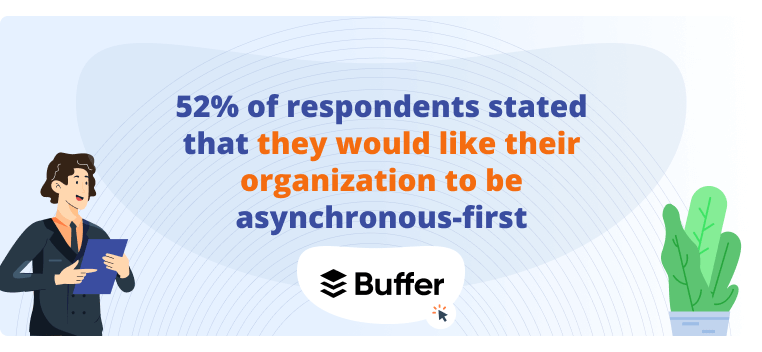40+ Internal Communications Statistics for Amazing Company Success
Internal communication ensures that all everyone is aware of the company’s goals and objectives. And the team should be working together towards the realization of these goals. Its second biggest purpose is to help improve morale, efficiency, and team spirit.
However, internal communication can be challenging. Employees may have different opinions and ideas on what and how to communicate. Let’s not forget how people communicated with others evolved during the COVID-19 pandemic.
This article speaks to the newest internal communications statistics. It will help you create a clear and effective internal communication strategy that will keep your teams on the same page.
How Poor Workforce Communication and Lack of Employees Collaboration Will Cost You
It’s no secret that gaps form in communication between management and employees. It’s often a pain point for many organizations. The problem is that leaders aren’t even aware of the missteps they take. Many have no communication objectives to help increase employee productivity.

In fact, internal communication statistics show 91% of people believe their bosses lack communication skills. Due to this, 57% of deskless workers rely little on managers to share corporate information with them.
The problem with poor communications stems from not having a long-term strategy in the first place. A company cannot have a communication strategy when its employees are not aligned with its values or corporate purposes. To address this, organizations must build a solid marketing communication strategy that connects internal messaging with overall business goals.
Even the onboarding process for new employees is less than helpful. Only 12% of employees strongly agree that their company has a great onboarding strategy.
That’s why 53% of the world’s organizations say their top priority is engaging their teams. They need to be consistent in their communication around strategy, values, and purpose.
If company executives are ineffective at communication, it will trickle down to the frontline workers. If your frontline workers are not happy, your company risks high turnover and loss of profit.
To meet their needs, make sure you provide them with context of when and why things in the company change. Notably, 65% of frontline leaders believe they have effective communication strategies, but only 35% of frontline workers feel heard. This highlights the importance of transparent communication to bridge the gap between management and employees.
When management fails to communicate, employees become less engaged. Sadly, an alarming 85% of employees are disengaged today.
The reason for being disengaged at work has to do with employee morale and satisfaction. Poor communication drives poor employee morale. 33% of HR managers believe poor communication cannot be taken lightly.
Low employee morale transforms into low employee productivity, which in turn transforms into a loss of budget. Some studies show that 34% of employees’ salary is spent on lost productivity. Furthermore, work-related stress costs around $500 billion per year.
Another factor that creates disengaged employees is boredom. Statistics show:
- 80% of employees aren’t learning new skills
- 44% say they have no challenges at work
- 30% don’t have enough work to keep them busy
The solution to this problem is to include your employees more actively in the needs of the company. Recognize their work, offer new training, but above all, communicate with them.
81% of employees would leave their job for a better alternative. This makes sense as only 31% of executives discuss employee experience.
Communication channels need to be measured to test their effectiveness but this is a challenge for companies. 27% of companies lack analytics and measurement in their communication. And of those top-tier companies, 46% are in North America.
By measuring your communication channels, you will be able to outrun others. Many organizations confess their primary communicators only keep track of 1 or 2 of their top-used channels. This said, disengaged employees will not be your top challenge and 37% of respondents agree.
The Role of the Pandemic in Internal Communication

The workplace evolved in 2020 with the onset of the pandemic. Today, we’re juggling hybrid workplaces and effective workplace communications with remote workers. In fact, hybrid models of work have become the second highest priority for 39% of organizations. This makes sense as, during the height of the pandemic, 88% of organizations recommend that employees work from home.
This is a good thing. Employers and employees are on the same page regarding home offices. 73% of workers want to work from home and 85% of managers think having remote teams will become a new norm.
Many employers are not opposed to it either. Companies with a remote work option see a profit increase of $2000 per remote worker, only adding to the bottom line.
That said, working from home has caused a few changes as well. For example, the number of emails sent and received daily skyrocketed to 319.6 billion. This is expected to rise to 376.4 billion by 2025. Also, Zoom became one of the fastest growing apps during the pandemic with the number of participants increasing by 2900%.
If it’s not clear already, people prefer digital channels such as email, Zoom, and Slack over classic meetings. According to a remote-work study, 52% of respondents stated that they would like their organization to be asynchronous-first.

Such a life-changing event on a global scale didn’t come without consequences.
- Only 47% of companies were able to deal with the new crisis
- Almost 40% of workers say their company showed no interest in their wellbeing since the start of the pandemic
- 57% of employees feel greater anxiety
- 75% of workers felt more socially isolated now that they’re working from home
Executives have struggled during this time too. Only 13% of employees strongly agree that leaders communicate information effectively with the rest of the company. But over 90% of workers declared they wanted more frequent communication from the company during the pandemic.
While some employees want more regular communication with the company, others feel overwhelmed by it.
- 22% have difficulties disconnecting from work
- 38% of employees feel burnt out after online meetings
- 38% of workers state email overload and fatigue as a possible reason for quitting their job
Now more than ever there is a trend for open and honest communication with employees on all levels. Make time and ensure that they are not overwhelmed by unnecessary messages, calls, or meetings.
Internal Communications Post-COVID
There are some positive internal communications statistics coming out of the pandemic. 68% of employees state that the pandemic has improved internal communications in their organization. Furthermore, 85% of employees feel more connected when there is effective communication. This leads to improved productivity (and sales) by 18%.

Other sources state that companies with engaged employees outperform those without by 202%. And having an effective internal communications strategy brings 47% higher returns to stakeholders.
This brings us to the importance of using proper technologies if you want to keep up with the modern digital era. A recent study on top channels used for communications among organizations finds that email is at the top. 93% of communicators use email regardless of the type or size of the company.
According to the same study, virtual and video are in second place at 83%. Rising quickly at 34% are internal networking solutions like chat and real-time messaging. In short, if you’re not using visual and digital communication, you’re falling behind.
In fact, 84% of HR managers say that employees will use engagement and collaboration technologies more over the next period. A 2025 internal communications report found that organizations with strong internal communication practices see a 21% increase in productivity — reinforcing the case for adopting modern communication tools. Employees are happier and more productive with digital tools too — 71% of employees love them.
81% of respondents state that internal communicators shape the tone of voice and influence how leaders talk to people. The same study also says that 88% of organizations value employee feedback. Translated, this means companies are aware of how valuable the employee experience is for the company. By improving the employee experience, employers can reduce employee turnover by 24%.

Another element you should take into consideration is the importance of having friendships in the workplace. 92% of people state that friendships at work are crucial for them to stay at their job. In fact, 1 in 4 people have a work friend they haven’t yet met in person.
Moreover, 21% of employees state that they feel more creative when they work alongside friends. We all like working with friends, right? 57% of people say that work is more enjoyable with their “work best friend.”
Not everyone feels this way though. A study by Capterra finds that employees, especially remote, aren’t that keen on nurturing work friendships. The pandemic has changed in-office norms around culture.
Companies like Apple and Google were lauded for their in-office playgrounds of ping-pong tables and video game rooms. Today, employees prefer better salaries over perks and many don’t want friendships with colleagues being shoved down their throats.
Circling back, this is why employers should listen to their employees. Employees will voice their opinions on what would make them happier and more engaged at work.
Boost Your Internal Communications With GaggleAMP
Internal communication tools are meant to keep employees up to date on company news and changes without disrupting their workflow. The more employees are informed, the closer they feel to your organization and are willing to participate. In short, good internal communication increases employee engagement, which in turn improves productivity and profit.
The easiest way to improve your internal communications strategy is by listening to your employees. Adopting software can make it easier to communicate. Chat, video, and file sharing software make it easy to share regardless of location. Some software can have dual purposes.

GaggleAMP is a communication tool that will keep your employees connected regardless of whether they work remotely or in the office. Our Community module gives your team an internal communications network to better share ideas. And our employee advocacy platform helps employees to better participate in external social media campaigns. These both help contribute to the company's outcomes and goals.
You can try our trial version for 14 days absolutely free.








